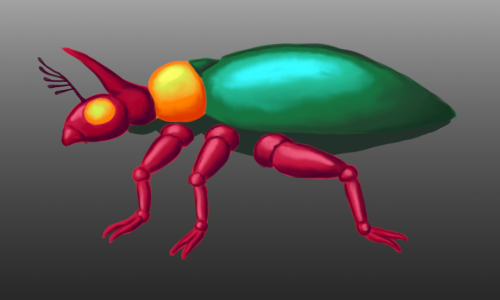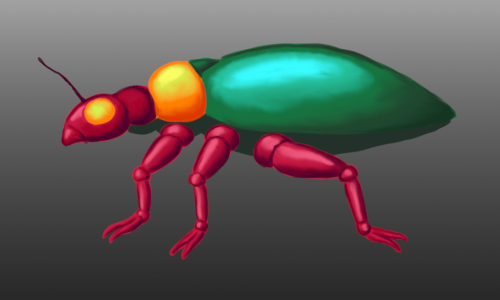Kemruna Beetle
An insect species which is said to have the best meat on Ranul.
Basic Information
Anatomy
Both the larva and the imago have six legs with two toes each. They have one head with two large compund eyes and a set of strong mandibles.
The larva has an additional set of mandibles underneath its chin. Its body is segmented into six parts and ends in three short tails.
The imago's body is covered with a hard carapace on the upper side. This includes the protective outer wings which hide a pair of soft, inner wings that are used for flying. Additionally, the neck carapace of male beetles is adorned with two large horns.
Coloring
The larva is of a matte, light green color with brown legs, mandibles and eyes. Its body is covered with a camouflage pattern of darker stripes. In contrast, the adult beetle's carapace shows vibrant colors with a metallic sheen. The outer wings are of a blueish green while the head, neck and legs are ruby red. The eyes and the thorax carapace are of a bright orange yellow.Growth Rate & Stages
Kemruna beetles start out as larvae with a length of about 20 centimeters and a diameter of about 5 centimeters.
Over the course of 8 years, they grow to a length of about 1.7 meters and a diameter of about 35 centimeters.
They then turn into a pupa and take approximately 6 years to transform into their imago.
Meat cattle is usually killed around the age of 32 years.
Breeding stock can live up to 170 years, growing up to 50% in size until then.
Dietary Needs and Habits
The larvae consume mostly leafy shrubbery, smaller succulents and mushrooms. The diet of adult beetles also includes fruit and smaller insects.
Additional Information
Domestication
Almost all Kemruna beetles on modern Ranul are kept as cattle. They are descended from the domesticated Diruna beetles which the surivivors of the Final War had taken with them to the bomb shelters.
Uses, Products & Exploitation
As with all cattle the Rilsu keep, very little goes to waste when the animal is killed. This holds especially true for this prestigious breed of beetles.
Products of Kemruna beetles are generally more expensive and less widely available than the equivalents created from related species.
Meat
Kemruna beetles are primarily bred for their meat which is rich in protein and iron. The most popular cuts are the muscle strands which move the wings and those inside the femurs. To stimulate muscle growth, the beetles are kept active and given large spaces to run or fly in. They are also fed high-quality fruit and smaller feeder insects with the aim of improving the flavor of the meat.Internal Organs
The beetle's organs are commonly prepared as stew or baked into pies. There are also various types of sausage based on specific organs.Haemolymph
The fluid in the beetle's circulatory system is a popular ingredient in soups and fitness drinks.Exoskeleton
The outer chitin plating is broken into smaller pieces which are served as appetizers or prepared as salads. Fragments which are too small for that purpose are ground into a powder which serves as a base ingredient in various recipes. For example, this powder is used to make sauces, baked goods or candy.Wings
The soft inner wings are processed into chitin fibres which serve as a raw material for certain light but sturdy fabrics.Eggs
Unfertilized eggs are usually cooked and cut into thin slices which are then prepared as salads or served as bread topping.
Genetic Ancestor(s)
Lifespan
32 - 170 years
Average Height
0.5 - 0.7 meters (meat cattle)
0.8 - 1.0 meters (breeding stock)
0.8 - 1.0 meters (breeding stock)
Average Length
1.3 - 1.5 m (meat cattle)
1.9 - 2.2 m (breeding stock)
1.9 - 2.2 m (breeding stock)






Comments